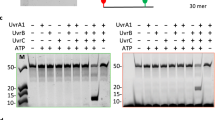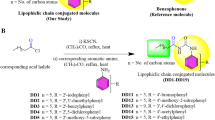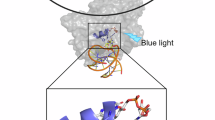Abstract
FOLLOWING infection of a suitable host by bacteriophage T4, a phage-specific endonuclease that makes single-strand breaks in ultraviolet-irradiated DNA1,2 is produced. This enzyme is presumably involved in pyrimidine dimer excision, since a mutant phage T4ν1, which does not produce detectable enzyme, is abnormally sensitive to ultraviolet light and fails to excise dimers from its DNA3. This endonuclease has been extensively purified4. Previous in vitro studies utilizing sedimentation velocity of DNA in sucrose density gradients showed ultraviolet dose-dependent reduction in sedimentation velocity of ultraviolet-irradiated T4 and T7 DNA following incubation with the purified enzyme. The sedimentation velocity of unirradiated DNA was not detectably reduced. Furthermore, the average number of enzymatically-induced nicks per molecule correlated well with the calculated number of dimers per molecule4. These studies suggested that the only substrate sites in ultraviolet-irradiated DNA were pyrimidine dimers. Unirradiated DNA was unaffected by the enzyme and it was concluded that such DNA either does not contain areas of distortion in the secondary structure such as might be produced by pyrimidine dimers, or if such distortions are present they are not recognized as substrate sites by the endonuclease.
This is a preview of subscription content, access via your institution
Access options
Subscribe to this journal
Receive 51 print issues and online access
$199.00 per year
only $3.90 per issue
Buy this article
- Purchase on SpringerLink
- Instant access to full article PDF
Prices may be subject to local taxes which are calculated during checkout
Similar content being viewed by others
References
Friedberg, E. C., and King, J. J., Biochem. Biophys. Res. Commun., 37, 646 (1969).
Yasuda, S., and Sekiguchi, M., J. Mol. Biol., 47, 243 (1970).
Harm, W., Virology, 19, 66 (1963).
Friedberg, E. C., and King, J. J., J. Bact., 106, 500 (1971).
Setlow, R. B., Swenson, P. A., and Carrier, W. L., Science, 142, 1464 (1963).
Vinograd, J., Lebowitz, J., Radloff, R., Watson, R., and Laipis, P., Proc. US Nat. Acad. Sci., 53, 1104 (1965).
Clayton, D. A., Davis, R., and Vinograd, J., J. Mol. Biol., 47, 137 (1970).
Boyle, J. M., and Setlow, R. B., J. Mol. Biol., 51, 131 (1970).
Howard-Flanders, P., and Boyce, R. P., Rad. Res. Suppl., 6, 156 (1966).
Author information
Authors and Affiliations
Rights and permissions
About this article
Cite this article
FRIEDBERG, E., CLAYTON, D. Electron Microscopic Studies on Substrate Specificity of T4 Excision Repair Endonuclease. Nature 237, 99–100 (1972). https://doi.org/10.1038/237099a0
Received:
Revised:
Issue date:
DOI: https://doi.org/10.1038/237099a0
This article is cited by
-
Is “dark water” really dark?
Radiophysics and Quantum Electronics (2011)
-
A pyrimidine dimer–DNA glycosylase activity associated with the v gene product of bacteriophage T4
Nature (1980)
-
The structural organization of calf retinal photoreceptors derived from freeze-fracture study
Molecular Biology Reports (1974)



